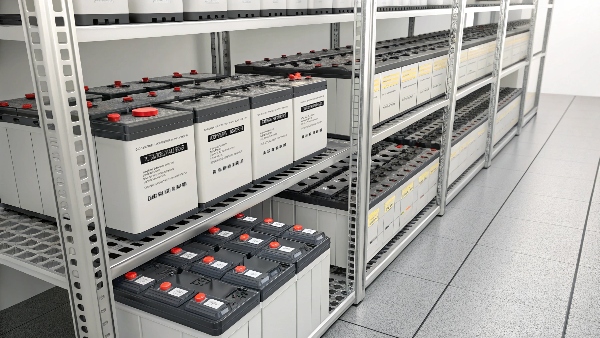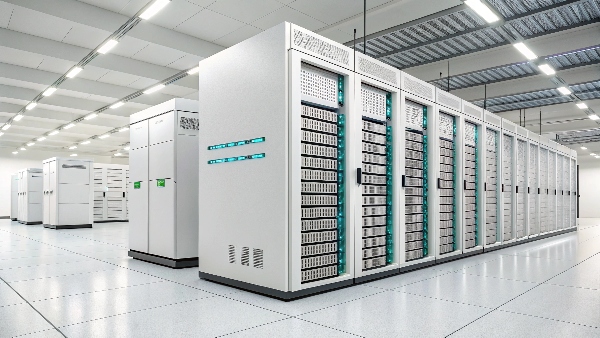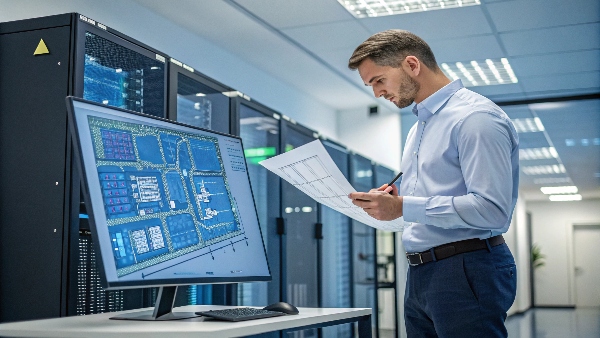The term "data center infrastructure" sounds technical, but what does it actually include? Understanding this concept is key to grasping how our digital world functions smoothly and reliably.
Data center infrastructure refers to all the core physical or hardware-based resources and components. This includes IT equipment like servers and storage, plus the essential facility support systems such as power, cooling, cabling, and physical security systems required to house and operate the IT environment.

Transition Paragraph:
Essentially, it's everything tangible that makes a data center work. At Daopulse, we specialize in a critical piece of this puzzle: the uninterruptible power supplies (UPS) that ensure IT equipment keeps running. My insight here is that managing a data center is very important. Proper management of all infrastructure components is vital for uptime and efficiency. Let's break down these foundational elements.
What is a UPS battery?
Power outages happen. How do critical systems like those in data centers stay online during those crucial first moments? The answer often lies in a specific type of battery.
A UPS battery is the energy storage component within an Uninterruptible Power Supply (UPS) system. It provides immediate backup power to connected equipment during a utility power failure, bridging the gap until mains power is restored or a backup generator starts up, preventing data loss or hardware damage.

Dive deeper Paragraph:
The UPS battery is the unsung hero during a power flicker or a complete blackout. Its job is simple but absolutely critical: provide instant, clean power when the primary source fails. At Daopulse, we manufacture both lead-acid and advanced lithium battery UPS solutions, and I've seen countless times how these batteries save the day. Managing a data center is very important, and that includes meticulous management of battery health.
Here's a closer look:
- Function: When the UPS detects a problem with the incoming utility power (e.g., outage, sag, surge), it instantaneously switches to battery power. This happens so quickly (milliseconds) that the connected IT equipment (servers, storage, network gear) doesn't even notice the switch and continues to operate without interruption.
- Types:
- Lead-Acid Batteries: For many years, Valve Regulated Lead-Acid (VRLA) batteries have been the workhorse in data center UPS systems. They are relatively cost-effective and reliable when properly maintained. We offer robust lead-acid UPS solutions.
- Lithium-Ion Batteries: These are increasingly popular due to their longer lifespan (often 2-3 times that of VRLA), smaller footprint, lighter weight, faster recharge times, and ability to operate at higher ambient temperatures. Our lithium battery UPS solutions cater to modern energy demands.
- Runtime: The amount of time a UPS battery can power the load depends on the battery's capacity (measured in Ampere-hours, Ah) and the power draw of the connected equipment. This runtime is typically designed to be a few minutes – long enough to either ride out a short outage or allow time for backup generators to start and stabilize.
- Maintenance: UPS batteries have a finite lifespan and require regular monitoring, testing, and eventual replacement. Neglecting battery maintenance is a common cause of UPS failure.
The UPS battery is a cornerstone of power reliability in any critical facility. Without it, even the most sophisticated data center would be vulnerable to the briefest power interruption, leading to potential data corruption, hardware damage, and costly downtime.
| Battery Type | Advantages | Disadvantages | Typical Lifespan |
|---|---|---|---|
| Lead-Acid (VRLA) | Lower initial cost, proven technology, widely available. | Heavier, larger footprint, shorter lifespan, temperature sensitive. | 3-5 years |
| Lithium-Ion | Longer lifespan, smaller, lighter, faster recharge, wider operating temperature range, better cycle life. | Higher initial cost, newer technology in UPS (though maturing fast). | 10-15+ years |
How is Google using lithium-ion batteries in its data centers?
Google operates some of the world's largest data centers. Are they sticking with traditional battery tech, or embracing newer solutions for their critical power needs? Their choices often signal industry trends.
Google is increasingly adopting lithium-ion batteries in its data centers. They are replacing traditional lead-acid batteries to improve reliability, reduce footprint, increase operational efficiency, lower cooling needs, and support their sustainability goals due to the longer lifespan and better performance characteristics of lithium-ion.

Dive deeper Paragraph:
Google's scale of operations means that even small improvements in efficiency or reliability can have a massive impact. Their move towards lithium-ion batteries for UPS systems in their hyperscale data centers is a significant indicator of the technology's benefits. At Daopulse, we've also seen a growing demand for our lithium battery UPS solutions from clients looking for similar advantages. Managing a data center is very important, and Google's adoption highlights how advanced battery technology contributes to better overall management and operational excellence.
Here's why Google and other hyperscalers are making the switch:
- Longer Lifespan: Lithium-ion batteries typically last 10-15 years or more, compared to 3-5 years for VRLA batteries. This significantly reduces the frequency of battery replacements, lowering maintenance costs, labor, and the risk associated with replacement activities.
- Smaller Footprint & Lower Weight: Lithium-ion batteries are much more energy-dense. They can provide the same amount of backup power in a package that is up to 60% smaller and 70% lighter than lead-acid equivalents. This frees up valuable data center floor space for more IT equipment.
- Improved Efficiency & Performance: They can handle more charge/discharge cycles, charge faster, and maintain performance better at higher ambient temperatures. This can lead to reduced cooling costs for the battery rooms.
- Enhanced Monitoring & Management: Modern lithium-ion battery systems often come with more sophisticated battery management systems (BMS), providing better insight into battery health and performance, which aids in predictive maintenance.
- Total Cost of Ownership (TCO): While the initial purchase price of lithium-ion is higher, the longer lifespan, reduced maintenance, lower replacement costs, and potential energy savings (e.g., from reduced cooling) can result in a lower TCO over the life of the data center.
- Sustainability: The longer life reduces the environmental impact associated with manufacturing and recycling batteries.
Google has publicly discussed retrofitting existing data centers with lithium-ion batteries and incorporating them into new builds. This strategic shift underscores the operational and financial benefits that these advanced battery technologies offer at scale, reinforcing the idea that investing in superior infrastructure components is key to efficient data center management.
| Feature | Lead-Acid UPS Batteries | Lithium-Ion UPS Batteries (Google's Focus) |
|---|---|---|
| Lifespan | Shorter (3-5 years) | Longer (10-15+ years) |
| Footprint/Weight | Larger / Heavier | Smaller / Lighter |
| Maintenance | More frequent testing and replacements | Less frequent replacements, advanced BMS |
| Temperature | Sensitive, requires controlled environment | More tolerant of higher ambient temperatures |
| Upfront Cost | Lower | Higher |
| TCO | Can be higher due to frequent replacements | Often lower over data center lifecycle |
What ability should a data center designer have?
Designing a data center is a complex, multi-disciplinary challenge. What specific skills and knowledge must a designer possess to create these vital, high-performing facilities successfully?
A data center designer must have strong abilities in electrical and mechanical engineering (power distribution, cooling), IT systems knowledge, understanding of building codes and safety standards, risk assessment, project management, and increasingly, knowledge of energy efficiency and sustainable design practices.

Dive deeper Paragraph:
A data center designer is like the master architect and engineer of these highly specialized buildings. They need a broad and deep skill set to balance the competing demands of reliability, efficiency, scalability, security, and cost. At Daopulse, we often collaborate with designers to ensure our UPS systems integrate seamlessly into their overall power infrastructure plans. Managing a data center is very important, and that effective management starts with a robust and well-thought-out design.
Key abilities include:
- Power Systems Design: Deep understanding of electrical engineering principles, including power load calculations, redundancy levels (N, N+1, 2N), UPS sizing and configuration, generator integration, switchgear, and power distribution from utility to rack level. They must ensure clean, reliable power.
- Cooling and Mechanical Systems Design: Expertise in thermodynamics, airflow management, and various cooling technologies (e.g., CRAC/CRAH units, chillers, economizers, liquid cooling). They must design for optimal temperature and humidity control while maximizing energy efficiency.
- IT Infrastructure Knowledge: Familiarity with server, storage, and network architectures to understand their power, cooling, and space requirements. This includes rack layouts, cabling infrastructure, and connectivity.
- Codes, Standards, and Compliance: Thorough knowledge of relevant building codes, electrical codes (e.g., NEC), fire safety regulations (e.g., NFPA), and industry standards like the Uptime Institute Tiers or TIA-942. Our products' CE, RoHS, and ISO certifications help designers meet these.
- Risk Assessment and Mitigation: Ability to identify potential points of failure and design solutions to mitigate them, ensuring high availability and resilience.
- Space Planning and Layout: Optimizing the physical layout for efficient use of space, airflow, equipment access, and future expansion.
- Project Management Skills: Ability to coordinate with various stakeholders, manage budgets and timelines, and oversee the implementation of the design.
- Energy Efficiency and Sustainability: Growing importance is placed on designing for low Power Usage Effectiveness (PUE), incorporating renewable energy sources, and utilizing sustainable materials and practices.
- Communication Skills: Effectively communicating complex technical designs to clients, contractors, and internal teams.
A successful data center designer integrates all these elements to create a facility that meets the client's current needs while being adaptable for future technological advancements and growth.
| Skill Domain | Key Competencies for Data Center Designer | Impact on Data Center |
|---|---|---|
| Electrical | Power system topology, redundancy, UPS/generator sizing, distribution. | Reliability, uptime, operational cost. |
| Mechanical | Cooling strategies, airflow management, psychrometrics, energy recovery. | Efficiency, equipment lifespan, PUE. |
| IT & Networking | Rack layouts, cabling pathways, network architecture understanding. | Scalability, manageability, performance. |
| Regulatory | Building codes, safety standards, environmental compliance. | Legal operation, safety, risk mitigation. |
| Project Mgmt. | Budgeting, scheduling, vendor coordination, quality control. | On-time and on-budget delivery, meeting specifications. |
| Sustainability | Energy efficiency, renewable integration, lifecycle assessment. | Reduced environmental impact, lower operating costs. |
What is a managed data center facility?
Businesses need data center services, but not all want to build or run their own. What option provides the physical infrastructure without the day-to-day operational burden?
A managed data center facility, often a colocation provider, offers leased space, power, cooling, and connectivity for a client's IT equipment. The provider manages the facility's core infrastructure (power, HVAC, security), while the client typically manages their own servers and applications within their leased space.

Dive deeper Paragraph:
A managed data center facility offers a compelling solution for many organizations. It provides the robust physical environment of a purpose-built data center without the significant capital expenditure and ongoing operational complexities of owning and managing one. At Daopulse, many of our OEM/ODM UPS systems are deployed in such facilities, providing reliable power to the tenants. Managing a data center is very important, and in this model, the facility provider takes on the critical management of the core infrastructure.
Here's what characterizes a managed data center facility (often referred to as colocation):
- Shared Infrastructure, Dedicated Space1: The provider owns and operates the building, power systems (including UPS and generators), cooling systems, and physical security. Clients lease specific amounts of space (e.g., racks, cages, or private suites) to house their own servers, storage, and networking gear.
- Core Facility Management by Provider: The provider is responsible for the uptime and maintenance of the shared critical infrastructure. This includes ensuring power availability according to the Service Level Agreement (SLA), maintaining optimal environmental conditions, and managing physical access controls.
- Client Manages IT Equipment: Typically, the client (tenant) is responsible for installing, configuring, managing, and maintaining their own IT hardware and software applications deployed within their leased space. Some providers may offer "remote hands" or "smart hands" services for an additional fee to assist with these tasks.
- Connectivity Options: Managed facilities usually offer rich connectivity options, with access to multiple telecommunication carriers and internet service providers, allowing clients to choose an N+1 redundancy configuration.
- Scalability2: Clients can often scale their space, power, and connectivity up or down as their needs change, offering more flexibility than building a private data center.
- Cost Benefits3: This model converts capital expenses (CapEx) of building a data center into operational expenses (OpEx) of leasing space, which can be financially attractive. It also leverages the provider's economies of scale.
This model is popular with businesses of all sizes, from small enterprises needing a couple of racks to large companies requiring significant caged space. It allows them to focus on their core business and applications, while entrusting the complex and critical facility management to a specialized provider. Procurement managers often look to these facilities for reliable, certified environments.
| Aspect of Managed Facility | Provider Responsibility | Client Responsibility (Typically) |
|---|---|---|
| Physical Space | Building, rack/cage/suite provision | Utilizing leased space for IT equipment |
| Power | Utility feeds, UPS, generators, power distribution to rack | Powering on/off servers, internal rack PDU management |
| Cooling | HVAC system operation, environmental controls | Ensuring proper airflow within their own racks |
| Physical Security | Building access control, surveillance, site security | Security of their own equipment within their space |
| Network Connectivity | Providing cross-connects, carrier-neutral environment | Contracting with carriers, managing their own network |
| Core Infrastructure Uptime | Ensuring SLA for power, cooling, network availability | Managing application uptime, OS, server hardware |
Conclusion
Data center infrastructure encompasses all physical IT and facility systems. Reliable UPS batteries, like advanced lithium-ion options used by Google, are vital. Skilled designers and well-managed facilities ensure overall operational success.
-
Exploring this resource will provide insights into how shared infrastructure enhances efficiency and cost-effectiveness in colocation data centers. ↩
-
Understanding scalability in data centers is crucial for businesses looking to adapt to changing needs without significant investment. ↩
-
This link will help you discover how colocation can transform capital expenses into operational savings, making it a smart financial choice. ↩

